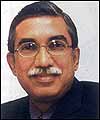













|
Regaining Lost
Ground
Ashwin
Udyog is not exploiting the power of scale, reach, and equity it has built
up over the years. The threat to its market leadership comes not from
external factors such as the move forward towards customisation but from
its own mindset of a monopoly. Two questions are relevant. How much of the
loss of marketshare is because of migration of customers towards
progressively higher ends of the market? And how much of it is because of
factors related to product quality, features, and service? In the answers
lies a clue to developing and positioning the next generation of Ashwin's
offerings. The launch would take two to three years.
|
|

"Ashwin's
threat comes from its mindset of a monopoly"
V. Venugopal, Executive
V-P, M&M
|
|
Meanwhile, Ashwin should focus its efforts
on consolidation. The company, in my view, should not let go of its hold
on the low end. VFM is an attractive plank. The popular segment of the
market can never flatten out in a huge country like ours. A surefire way
for Ashwin to consolidate its hold is to recognise that revenues come from
many sources, not from the sale of the car alone.
- Look at the spare parts market in the
country. It is unorganised. If Ashwin were to step in, the payoffs
would be enormous. The process could begin with a campaign aimed at
educating the customer about the imperative of using genuine spares.
Given the right support system, no customer minds buying a genuine
part at a higher price. It enhances dealer revenues and provides an
incentive for the dealer to move the main product. Servicing is
another source of revenue. Customer relationship management would be
the key driver in this initiative.
- Ashwin could also consider trading in
second-hand vehicles. The mission here is to tap customers looking for
opportunities to migrate to their first four-wheeler. This, again, is
an area where Ashwin could leverage its volumes and enter a segment
waiting to be tapped.
- The car rental business may also provide
an ideal diversification option for Ashwin. I think this is a segment
which is under-rated. With a fleet of its own cars, Ashwin is in a
commendable position to exploit niches like these. At a higher level,
logistics could be a good source of revenue. How about providing, for
instance, inward and outward supply for its own vendors at a price, to
start with?
- Given the fact that its assets are fully
depreciated, and Ashwin can afford to sell cars at a price slightly
above its variable costs, I think exports are worth a look. Africa,
North America, and even parts of Asia are good target markets.
- How about getting into multi-utility
vehicles? There is a market for these in India. Can Ashwin develop
them with incremental investments and by tweaking the existing
facilities just that bit?
Technology is not a major issue at Ashwin.
Bringing a strong brand mindset into its operations is. Ashwin should stop
being a hostage to its past and start thinking out of the box. It is only
then that it will be able to regain lost ground.
Consider
a general who is ensconced within a fortification in a corner of his
kingdom. As the kingdom grows in different directions, the general does
not straddle the expanding space. He merely defends his original turf.
Inevitably, he leaves large patches of his kingdom open to invasion-and
occupation-by the enemies. And gets reduced, over a period of time, to a
non-entity. Ashwin Udyog is in a similar predicament.
|
|

"Ashwin
should get rid of corporate brand personality of VFM"
Raj Nair,
Chairman, Business
Consulting Group
|
|
Its entry strategy was no doubt sensible:
offer VFM cars at the entry-level. But it ignored the high priced
segments-till competition set in. Even there, it decided that the VFM
personality would suffice. It did not recognise that there were many other
marketing planks available.
Another mistake was that even in the small
car category it focussed on the single-car owner. It missed out the second
and third car owner whose needs and aspirations are different from what
Ashwin's basic models offer.
The benefits expected from a car are both
tangible and intangible. Ashwin's models are excellent in terms of
tangibles. But they are weak on intangibles. Today, a car is a statement
of the owner's status. In sophisticated car markets like the US, research
has established a clear correlation between the model and colour of car,
and the owner's socio-economic status, sex, and age. The car market there
has several multi-dimensional sub-segments. Automobile manufacturers plug
in models in the relevant ones with brand personality positions which are
compatible. If you do not have a model to offer, you finally lose the
segment.
A decade-and-half after Ashwin Udyog's
entry, the Indian consumer is more sophisticated, has more disposable
income, and access to numerous car finance schemes that help him reach out
to premium products. In fact, the Indian car market can no more be
segmented purely on price.
Ashwin has evolved all right, but far too
slowly. The management has wrongly positioned the whole company as one
that provides VFM products for the market, whereas the Indian market has
several consumers who do not want to be seen as VFM seekers when it come
to products like clothing, shoes, and cars. Competitors have plugged in
offerings that meet the aspirations of these consumers.
Since the Indian market is too small to
allow a big player like Ashwin to grow on a single platform, it must get
rid of corporate brand personality of VFM. And create individual
personalities for its numerous models. It must attack the market
aggressively to occupy new turf in certain strategic non-VFM segments,
while it continues to defend the VFM fortification with existing models.
This is a major change for Ashwin. But it must be done before it becomes
financially difficult for the company to pursue this aggressive strategy.
|
|

"Ashwin
should have taken the lead
in replacing its own old cars"
S.K. Palekar,
Sr. V-P (Marketing),
Eureka Forbes
|
|
As
retail consumer durable markets mature and become competitive, it becomes
difficult for a leader to maintain its marketshare. Competition increases
the choice at the customer level, not only of products but also of terms
and conditions of purchase. Simultaneously, at the dealer level, different
dealers develop their own brand affinities, which limit the access of the
non-aligned brands to the clientele of such dealerships. What are the
options before Ashwin?
It is true that the market for mid-size
cars is growing. But the conclusion that the market is ''drifting'' away
from small cars is misleading. It is a very different process of creation
of a 'replacement' segment of people who, when they come into the market
second time round, want a better product than they bought the first time.
Targeting the replacement segment created
by the collective efforts of previous marketers is a proven entry
technique in consumer durables market. It is hardly surprising that the
competitors spotted the opportunity of replacing the huge number of old
Ashwin cars much before Ashwin did. Ideally, Ashwin should have taken the
lead in replacing its own old cars. Even now, it can do four things:
- Since Ashwin's products have performed
well, and its after sales network is good, there is an opportunity for
conducting direct contact programmes to convince existing customers to
trade in their old cars for new products from Ashwin.
- In fact, its wide dealer and service
network will give Ashwin a tremendous edge in sponsoring the trade-in
cars: buying back old cars, reconditioning them, and then reselling
them.
- Ashwin could launch a special limited
edition model, which is available only to its existing customers under
a buy-back offer. This will set the market on fire.
- A scheme for existing customers to give
referrals and get benefits in the process of recommending their
existing brand to their friends and relatives, would be effective.
The real winner in the car market is still
the small cars segment. Although the rate of growth of the mid-size cars
segment was 160 per cent, we cannot ignore that the small cars one grew at
25 per cent-a respectable growth by any standard. There may be some
temporary problems in this segment, but I do not believe that the market
is migrating away from this position.
I believe there may actually be an
opportunity to rejuvenate the sale of small cars, but it cannot be tapped
through the traditional 'economy' position based on low fuel/maintenance.
The small car now needs to be positioned as the main car for small cities
and as the second car for main cities. Ashwin should launch a sub-brand to
make it exciting to own an economy model.
But this move will succeed only if two
things are done. The product should be re-designed to become young and
exciting. And, in small towns in particular, Ashwin must focus on
multi-brand dealers. This, of course, involves changing the very mindset
of the sales force and the very paradigm of the car market.
Send us your solution

Readings List
|

